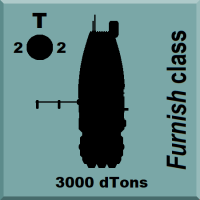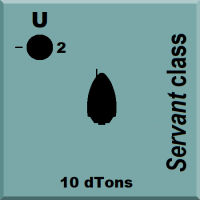Difference between revisions of "Furnish class Tanker"
| Line 184: | Line 184: | ||
* The refining plant and fuel pumping equipment are noisy. Engineering personnel wear ear protection and rely on [[Radio Communicator|personal communicators]] when working around them. | * The refining plant and fuel pumping equipment are noisy. Engineering personnel wear ear protection and rely on [[Radio Communicator|personal communicators]] when working around them. | ||
| − | The class was originally designed to have three [[Servant class Launch|launches]] and adequate hangar space was provided for them. These subcraft were intended to transport personnel while the vessel remained in orbit providing refuelling services and to act as lifeboats in an emergency. The class was only ever issued with two launches as standard (likely as a result of corporate cutbacks and penny-pinching) resulting in inadequate escape facilities for the crew in the event of their needing to evacuate the vessel. Individual owners and captains may upgrade by purchasing an additional subcraft if desired, though more often the vacant hangar space is used as extra cargo storage. | + | The class was originally designed to have three [[Servant class Launch|launches]] and adequate hangar space was provided for them. These subcraft were intended to transport personnel while the parent vessel remained in orbit providing refuelling services and to act as lifeboats in an emergency. The class was only ever issued with two launches as standard (likely as a result of corporate cutbacks and penny-pinching) resulting in inadequate escape facilities for the crew in the event of their needing to evacuate the vessel. Individual owners and captains may upgrade by purchasing an additional subcraft if desired, though more often the vacant hangar space is used as extra cargo storage. |
''Class Naming Practice/s:'' <br> Individual vessels are generally named by the organization that operates them. This is considered a serious affair and a ship with a frivolous name is considered "unlucky". Spacefarers tend to be superstitious and such vessels may find that they attract less commercial interest or are less favored for berthing slots, further adding to their unlucky reputation. | ''Class Naming Practice/s:'' <br> Individual vessels are generally named by the organization that operates them. This is considered a serious affair and a ship with a frivolous name is considered "unlucky". Spacefarers tend to be superstitious and such vessels may find that they attract less commercial interest or are less favored for berthing slots, further adding to their unlucky reputation. | ||
Revision as of 07:25, 24 September 2021
| Furnish class Tanker | |
|---|---|
 AAB Ship Reference File. | |
| Type: TF Tanker | |
| Category | BCS |
| Size | 3,000 Tons |
| Hull Configuration | Cone Hull |
| Streamlining | Streamlined Hull |
| Tech Level | TL–11 |
| Engineering | |
| Computer | 2x Model/3 |
| Jump | J-2 |
| Maneuver | 2 G |
| Armaments | |
| Hardpoints | 30 |
| Accommodations | |
| Staterooms | 0 |
| Personnel | |
| Crew | 32 / 40 |
| Officers | 10 |
| Enlisted | 22 |
| Marines | 0 / 8 |
| High/Mid Passengers | 0 |
| Payload | |
| Cargo | 20 (+1) Tons |
| Fuel tank | 660 (+1,600) Tons |
| Construction | |
| Origin | Unknown |
| Year Operational | Unknown |
| End of Service | Still in active service. |
| Price | |
| Cost | MCr1,458.140 (base) MCr1,166.512 (qty) |
| Architect fee | MCrAde Stewart |
| Statistics | |
| Quick Ship Profile | TF |
| Images | |
| Blueprint | No |
| Illustration | Yes |
| Source | |
| Also see | Auxiliary |
| Canon | Published, fan design |
| Era | 1105 |
| Reference | Fan: Ade Stewart |
| Starships are designed with the Classic Traveller format, using Classic Traveller Book 5 High Guard. | |
The Furnish class Tanker is an auxiliary.
- It is a paramilitary ship and a Tanker.
- It is used by military forces and by commercial organizations.
Description (Specifications)
The Furnish class is a large tanker vessel. It collects and refines hydrogen fuel and either transports it to a starport or provides it directly to another vessel.
- It is a TL–11 design.
- There are many variants.
These large and generally grubby ships may be encountered almost anywhere. Their outer skins become stained and darkened by trace chemicals while skimming gas giant atmospheres and they frequently exhibit dents and scrapes resulting from poor maneuvering while vessels are coming alongside to refuel. Commercial tankers may serve an organisation, supporting its operational craft and providing them with refined fuel on demand, or may operate as independent gas traders, selling fuel directly from their tanks, particularly in systems with starports that do not provide local refuelling facilities. Military tankers will generally be accompanied by at least one escort vessel.
Image Repository
General Description
The Furnish class is an auxiliary tanker with performance of J-2 and 2-G acceleration. It is a relatively large, relatively slow ship, equipped with strong sandcaster defenses and laser turrets most commonly used in a point defense role. The design is fully streamlined, giving good atmospheric performance, allowing it to skim for fuel, and enabling it to perform surface landings.
The vessel is an unevenly shaped cone with an overall length of 113 meters, a mean diameter of 37 meters, and a volume of approximately 40,500 cubic meters. The ship has many pods, blisters, cowlings, recesses, housings, and protuberances over its surface. Despite this slightly irregular shape it is aerodynamic and may operate within planetary atmospheres.
Basic Ship Characteristics
Following the Imperial Navy and IISS Universal Ship Profile and data, additional information is presented in the format shown here. The small craft factor indicates the number of squadrons (...of ten subcraft) carried on the ship. Tonnage on the universal ship profile is shown in kilotons (...thousands of tons) where necessary. [1]
| Basic Ship Characteristics [2] | ||
|---|---|---|
| No. | Category | Remarks |
| 1. | Tonnage / Hull | The Furnish class Tanker is constructed using a 3,000 dTon hull built in a generally conical configuration. The hull is streamlined and has good atmospheric capability: its atmospheric handling characteristics are improved by its onboard gravitic systems.
|
| 2. | Crew | x32 personnel (40 in military service).
Accommodations There are x25 Staterooms.
Accessible areas of the hull are fitted with grav plates and inertial compensators and have full life support and environmental systems.
|
| 3. | Performance | The vessel mounts a Jump-2 drive, a Maneuver-2 drive, and a fusion Power Plant-2, giving performance of Jump-2 and 2-G acceleration. The ship has an agility rating of 0 and an emergency agility of 2. The internal fuel tankage is sufficient for one Jump-2 and gives the power plant 4 weeks duration.
|
| 4. | Electronics | Adjacent to the bridge is a Model/3 computer. A backup Model/3 is installed in engineering.
The vessel is fitted with communications equipment, a standard sensor array, and has an avionics suite.
|
| 5. | Hardpoints | x30 hardpoints.
|
| 6. | Armament | The normal weapons fit-out for a Furnish class is:
x10 triple Beam Laser turrets, forming two batteries of 5 linked turrets. |
| 7. | Defenses | The hull has no additional armor.
x20 triple Sandcaster turrets, forming two batteries of 10 linked turrets.
|
| 8. | Craft | Flight Section:
x2 10-dTon Servant class Launches. The subcraft are housed in a dedicated hanger: the hanger can be sealed and has a total volume of 40 dTons. |
| 9. | Fuel Treatment | The vessel has internal fuel tankage of 660 dTons.
The vessel has commercial / refuelling tankage of 1600 dTons.
|
| 10. | Cost | The basic cost of the vessel is MCr1,458.140
The price does not include the cost of the launch:
With its subcraft, a discounted Furnish class costs MCr1,176.368 |
| 11. | Construction Time | 135 weeks as standard, 108 weeks in bulk.
|
| 12. | Comments | Standard cargo capacity amounts to 20 dTons.
The vessel has a small secure locker with a capacity of 1 dTon. |
History & Background (Dossier)
The design is representative of the class and large numbers of variants exist, particularly with regard to the accommodations, the fit out of internal spaces, the weapons systems, and the onboard electronics.
The boom arms that extend from the hull and transfer fuel to adjacent ships are easily damaged. The vessel carries multiple spares and extra components.
- Boom arm repair is one of the most unpopular jobs on the ship.
Class Naming Practice/s & Peculiarities
Vessel Peculiarities:
The design is capable of independent operations and can transport incidental supplies in their holds. The Furnish class develops a characteristic judder during fuel skimming operations, when the main tanks reach 50% capacity and auxiliary pumping gear begins transferring fuel to secondary tanks.
- The refining plant and fuel pumping equipment are noisy. Engineering personnel wear ear protection and rely on personal communicators when working around them.
The class was originally designed to have three launches and adequate hangar space was provided for them. These subcraft were intended to transport personnel while the parent vessel remained in orbit providing refuelling services and to act as lifeboats in an emergency. The class was only ever issued with two launches as standard (likely as a result of corporate cutbacks and penny-pinching) resulting in inadequate escape facilities for the crew in the event of their needing to evacuate the vessel. Individual owners and captains may upgrade by purchasing an additional subcraft if desired, though more often the vacant hangar space is used as extra cargo storage.
Class Naming Practice/s:
Individual vessels are generally named by the organization that operates them. This is considered a serious affair and a ship with a frivolous name is considered "unlucky". Spacefarers tend to be superstitious and such vessels may find that they attract less commercial interest or are less favored for berthing slots, further adding to their unlucky reputation.
- Individual vessels are issued specific serial numbers and transponder codes.
Selected Variant Types & Classes
References & Contributors (Sources)
| This article has metadata. |
- Marc Miller, Frank Chadwick, John Harshman. High Guard (Game Designers Workshop, 1980), 20-37. (Design Sequence Used)
- Author & Contributor: Lord (Marquis) and Master Scout Emeritus Adie Alegoric Stewart of the IISS
- Author & Contributor: Deekay Krause
- ↑ Timothy B. Brown. Fighting Ships (Game Designers Workshop, 1981), 10.
- ↑ Timothy B. Brown. Fighting Ships (Game Designers Workshop, 1981), 10.

